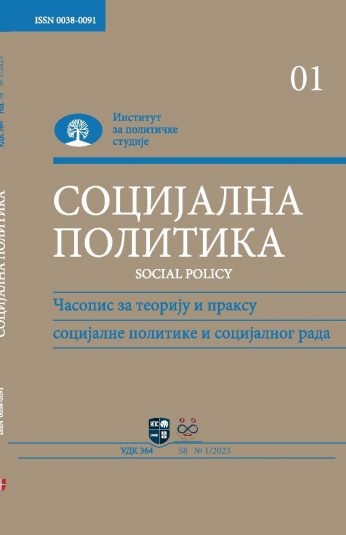Тема броја
ПРОГРАМИ И УСЛУГЕ ЗАШТИТЕ И ПОДРШКЕ ДЕЦИ У СИСТЕМУ СОЦИЈАЛНЕ ЗАШТИТЕ
FOSTER CHILDREN AND MENTAL HEALTH
Сажетак
Foster children are highly vulnerable social group, mainly because they are often exposed to the various types of violence. Literature is emphasizing higher prevalence of mental health diagnosis among the children from the child protection system, especially foster children, in comparison to general population of same age. Author stresses the different manners in which the approach based on risk jointly with tendention of medicalisation is used for management of inadequate behavior. Based on the concept of human rights and sociology of emotion and body, the paper defines basic principles for social workers. These principles of their work include: taking in consideration specific background of every child, understanding of deviant behavior, building of firm relations and respect for the opinion of every child.
Референце
- Abraham, John, “Pharmaceuticalization of Society in Context: Theoretical, Empirical and Health Dimensions”, Sociology, 44(4), 2010, pp. 603-622.
- Abrines, Neus et al., “Comparing ADHD symptom levels in children adopted from Eastern Europe and from other regions: Discussing possible factors involved”, Children and Youth Services Review, 34(9), 2012, pp. 1903-1908.
- Atwool, Nicola, “Working with Adults who are Parenting”,in: Social Work Theories in Action (eds. Kieran O’Donoghue, Mary Nash & Robyn Munford), Jessica Kingsley Publishers, London, 2005, pp. 223-238.
- Baumgaertel, Anna, Wolraich, L. Mark & Dietrich, Mary, “Comparison of diagnostic criteria for attention deficit disorders in a German elementary school sample”, Journal of the American Academy of Child and Adolescent Psychiatry, 34(5), 1995, pp. 629-638.
- Beckett, Chris:Essential theory for social work practice, SAGE, London, 2006.
- Bronfenbrenner, Urie: The ecology of human development: experiments by nature and design, Harvard University Press, Cambridge, 1979.
- Bronsard, Guillaume et al., “Prevalence rate of DSM mental disorders among adolescents living in residential group homes of the French Child Welfare System”, Children and Youth Services Review, 33(10), 2011, pp. 1886-1890.
- Bühler-Niederberger, Doris: Kindheit und die Ordnung der Verhältnisse: Von der gesellschaftlichen Macht der Unschuld und dem kreativen Individuum, Juventa, Weinheim and Munich, 2005.
- Cantwell, Nigel et al.: Moving forward: Implementing the Guidelines for the Alternative Care of Children, The Centre for Excellence for Looked After Children in Scotland, Glasgow, 2012.
- Committee on the rights of the child, 2009. General comment No. 12: The right of the child to be heard. CRC/C/GC/12.
- Conrad, P. & Schneider, J.W.: Deviance and medicalization. From badness to sickness, Mosby, Philadelphia, 1992.
- Cooper, Paul, “Understanding AD/HD: A Brief Critical Review of Literature”, Children & Society, 15(5), 2001, pp. 387-95.
- DGSP: Eine Generation wird krankgeschrieben. Die Aufmerksamkeitsdefizit-/ Hyperaktivitätsstörung (ADHS), Ritalin und Psychopharmaka, Deutsche Gesellschaft für Soziale Psychiatrie e.V., Köln, 2013.
- Donnelly, Jack:, Universal human rights in theory and practice, Cornell University Press, New York, 2003.
- Frances, Allen: Saving normal: an insider ’s revolt against out-of-control psychiatric diagnosis, DSM-5, Big Pharma, and the medicalization of ordinary life, Harper Collins, New York, 2013.
- Grugel, Jean & Piper, Nicola: Critical perspectives on global governance: rights and regulation in governing regimes, Routledge, Abingdon, 2007.
- Hazelton, Rosemary & Stalker, Carol, “Attachment Theory”, in: Theoretical Perpectives for Direct Social Work Practice: A Generalist-Eclectic Approach, Second Edition (eds. Peter Lehmann & Nick Coady), Springer Publishing Company, New York, 2007, pp. 109-127.
- IFSW, Definition of Social Work, 2000. Available at: http://ifsw.org/policies/definition-of-social-work/ [Accessed November 13, 2013].
- IFSW, Statement of Ethical Principles, 2012. Available at: http://ifsw.org/policies/statement-of-ethical-principles/ [Accessed November 13, 2013].
- Karnik, S. Niranjan, ”Categories of control: Foster children and ADHD”, Children and Youth Services Review, 23(9-10), 2001, pp. 761-780.
- Kerber-Ganse, Waltraut:, Die Menschenrechte des Kindes: Die UN-Kinderrechtskonvention und die Pädagogik von Janusz Korczak; Versuch einer Pespektivenverschränkung, Opladen & Farmington Hills, MI: Barbara Budrich, 2009.
- Leuzinger-Bohleber, Marriane & Haubl, Rolf, «Hilfe für kleine Störenfriede: Frühprävention statt Psychopharmaka Vom kritischen Umgang mit der Diagnose »Aufmerksamkeitsund Hyperaktivitätsstörung««, Forschung Frankfurt, (3/2007), 52-55.
- Liebel, Manfred: Wozu Kinderrechte: Grundlagen und Perspektiven, Juventa, Weinheim and Munich, 2007.
- McMillen, J. Curtis et al., “Prevalence of psychiatric disorders among older youths in the foster care system”, Journal of the American Academy of Child and Adolescent Psychiatry, 44(1), 2005, pp. 88-95.
- Prout, Alan: The future of childhood: towards the interdisciplinary study of children, Routledge, London and New York, 2005.
- Pupavac, Vanessa, “Misanthropy Without Borders: The International Children’s Rights Regime”, Disasters, 25(2), 2001, pp.95-112.
- Rafalovich, Adam, “Attention Deficit-Hyperactivity Disorder as the Medicalization of Childhood: Challenges from and for Sociology”, Sociology Compass, 7(5), 2013, 343-354.
- Rudin, Pascal: Die Bedeutsamkeit Erfahrbarer Würde. Betrachtungen zum menschenrechtlichen Verständnis von Kind und Kindheit und dessen Implikationen auf Bildung, VDM, Saarbrücken, 2011.
- Schmid, Marc et al., “Prevalence of mental disorders among adolescents in German youth welfare institutions”, Child and Adolescent Psychiatry and Mental Health, 2, 2008, p. 2.
- Singh, Ilina, “Biology in context: social and cultural perspectives on ADHD”, Children & Society, 16(5), 2002, pp. 360-367.
- SOS Children’s Villages International: Guidelines for the alternative Care of Children. A United Nations framework, SOS Children’s Villages International, Innsbruck, 2009.
- Staub-Bernasconi, Silvia: Vom beruflichen Doppelzum professionellen Drippelmandat. Wissenschaft und Menschenrechte als Begründungsbasis der Profession Soziale Arbeit, Unpublished Manuscript, Zürich and Berlin, 2007.
- Swiss National Advisory Commission on Biomedical Ethics, “Human enhancement by means of pharmacological agents”, Swiss Medical Journal, 92(43), 2011, pp. 1640-1653.
- Szasz, S. Thomas: The myth of mental illness: foundations of a theory of personal conduct, Harper & Row, New York, 1974.
- Wells, Karen:, Childhood in a global perspective, Polity Press, Cambridge, 2009.
- Woodhead, Martin, “Foreword”, in: A handbook of children and young people ’s participation: perspectives from theory and practice (eds. Barry Percy-Smith & Nigel Thomas), Routledge, Abingdon,2009, pp. xix-xxi.
- Zeiher, Helga, “Ambivalenzen und Widersprüche der Institutionalisierung von Kindheit” In: Ordnungen der Kindheit: Problemstellungen und Perspektiven der Kindheitsforschung (ed. Michael-Sebastien Honig), Juventa, Weinheim and Munich, 2009.
- Zito, M. Julie et al., “Psychotropic medication patterns among youth in foster care”, Pediatrics, 121(1), 2008, pp. 157-163.

